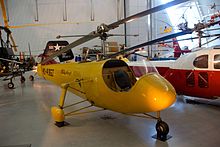Bell 30
| Bell 30 | |
|---|---|

| |
| Bell 30 flight testing | |
| Role | Experimental helicopter |
| National origin | United States |
| Manufacturer | Bell Aircraft |
| Designer | Arthur M. Young |
| First flight | 26 June 1943[1] |
| Introduction | 1943 |
| Retired | 1944 |
| Status | Preserved |
| Number built | 3 |
| Developed into | Bell 47 |
The Bell 30 was the prototype for the first commercial helicopter, and the first helicopter built by the Bell Aircraft Company.[2] Designed by Arthur M. Young, the type served as a demonstration testbed for the successful Bell 47.[2]
Development
Young had experimented alone with helicopter designs using scale models, and in 1941 he approached the Bell Aircraft Corporation in Buffalo, New York. The company agreed to build a number of full-scale prototypes, and Young moved to Buffalo. With the main Bell factories immersed in war production, and to ensure a research and development program that was sufficiently private and free of distractions, Young and his team moved to the Buffalo suburb of Gardenville (West Seneca). The Ship 1 prototype's first serious mishap occurred near the very end of 1942 in captive testing, when a Bell corporate pilot asked to try the Ship 1, while not using a seat belt and hanging onto the controls instead to stay in the open cockpit - this captive flight attempt resulted in the rotor system "going through resonance" as designer Arthur Young had warned about, resulting in a "bucking" instability and accident which cracked the rotor blades loose and sent the pilot up into the disc of the rotor blades, luckily only breaking an arm.[3] The first free flight of Ship 1 was carried out on June 26, 1943,[4] only the third American helicopter to fly.[5]
The Ship 1 prototype
Variants
Data from:Bell Aircraft since 1935[7]
- Ship No.1
- (c/n 1) The original Bell 30, built with an open-frame tubular steel framework with an open cockpit and four widely splayed undercarriage legs with skids at the ends, made from 3 in (76 mm) Aluminium alloy tubing. First flown on 29 December 1942, test flying continued until a serious crash in September 1943.
- Ship No.1A
- (c/n 1A) Ship No.1, rebuilt after the crash with a strutted tricycle undercarriage with nosewheel, and semi-enclosed cockpit, rejoined the test programme by March 1944.
- Ship No.2
- (c/n 2) The second aircraft was built with a new three wheeled undercarriage, semi-monocoque fuselage, new tail rotor mounting and fully enclosed cockpit for pilot and passenger.
- Ship No.3
- (c/n 3) The third aircraft was built with a triangular-section welded tubular steel tailboom, four-wheeled undercarriage, full set of instruments, but a completely open cockpit. Performance and handling of this aircraft were found to be much better than its predecessors but the open cockpit was viewed as a major handicap. Young described flying the aircraft as being "like sitting in a chair and flying through space." However, Bell company officials who flew in it found the experience to be thoroughly frightening.[8] The solution to the open cockpit was the plexiglas bubble that was to become iconic on Bell 47/H-13 production aircraft.

Surviving aircraft
Ship No.1A is on display at the National Air and Space Museum[citation needed]
Specifications
Data from [2]
General characteristics
- Crew: one
- Capacity: two passengers
- Powerplant: 1 × Franklin 6V4 flat-six piston engine, 160 hp (120 kW)
- Main rotor diameter: 33 ft 0 in (10.06 m)
- Main rotor area: 855.3 sq ft (79.46 m2)
Performance
See also
Related development
Aircraft of comparable role, configuration, and era
References
Notes
- ^ Note:Aerofiles has the date as the 29 December 1942
- ^ a b c d e The Illustrated Encyclopedia of Aircraft (Part Work 1982-1985). Orbis Publishing.
- ^ Helicopter Pioneers- first Bell Flight Testing (YouTube) (YouTube). Gardenville, NY: burgesco1. 1943. Event occurs at 4:40. Archived from the original on 2021-12-20. Retrieved July 25, 2015.
- ^ "Bell 30". kamov.net. Archived from the original on May 11, 2012. Retrieved May 9, 2012.
- ^ a b "American airplanes:Bell". www.aerofiles.com. 20 April 2009. Archived from the original on 2 January 2010. Retrieved 2009-12-23.
- ^ "Bell Model 30 Ship 1A Genevieve - Smithsonian National Air and Space Museum". Archived from the original on 2010-01-23. Retrieved 2012-03-25.
- ISBN 1-55750-056--8.
- ^ Gobel, Greg. "The Bell Model 47". www.airvectors.net.
Bibliography
- The Illustrated Encyclopedia of Aircraft (Part Work 1982-1985). Orbis Publishing.
- Pelletier, Alain J. (1992). Bell Aircraft since 1935. Annapolis: Naval Institute Press for Putnam Aeronautical Books Limited. pp. 55–58. ISBN 1-55750-056--8.
- "American airplanes:Bell". www.aerofiles.com. 20 April 2009. Archived from the original on 2 January 2010. Retrieved 2009-12-23.
External links
- Stabilizing Device on Tail Keeps Rotor Horizontal August 1944 article on Bell 30. Photo at bottom of page.
